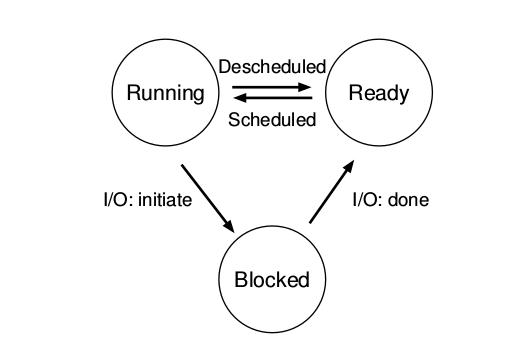介绍
什么是进程:简单来说就是一个正在运行中的程序 进程是程序的一次执行,包括代码和数据,是CPU分配资源的基本单位,一个进程可以包括多个线程。
进程之间通信方式:管道、SOCKET、信号量(互斥、同步)等。
子进程是父进程的复制品。子进程获得父进程数据空间、堆和栈的复制品。
线程是独立运行和独立调度的基本单位(线程比进程更小,基本上不拥有系统资源,故对它的调度所付出的开销就会小得多,能更 高效的提高系统内多个程序间并发执行的程度),线程之间共享进程的数据空间(借此通信)
进程接口
操作系统提供一些 API 给进程调用,例如 create 创建, destroy 销毁, wait 等, suspend 暂停, status 状态等。
1.fork()
fork函数复制了当前进程,生成子进程,子进程与父进程不完全相同,子进程有自己的资源,例如:address space (private memory), registers, PC。
子进程不会从 main 函数开始运行,只会从调用 fork 函数处开始运行。
fork调用的一个奇妙之处就是它仅仅被调用一次,却能够返回两次,它可能有三种不同的返回值:
1)在父进程中,fork返回新创建子进程的进程ID;
2)在子进程中,fork返回0;
3)如果出现错误,fork返回一个负值;
#include <stdio.h>
#include <stdlib.h>
#include <unistd.h>
int main(int argc, char *argv[])
{
printf("hello (pid:%d)\n", (int) getpid());
int rc = fork();
if (rc < 0) { // fork failed, exit
fprintf(stderr, "fork failed\n");
exit(1);
} else if (rc == 0) { // child (new process)
printf("hello, i am child (pid:%d)\n", (int) getpid());
} else { // parent goes down this path (main)
printf("hello, i am parent of %d (pid:%d)\n", rc, (int) getpid());
}
return 0;
}
/*
复制了当前进程的备份,称为子进程,子进程一般在父进程执行完后再执行,子进程不会从 main 函数开始
执行,而是从 fork 函数开始执行
大致结果:
hello (pid:10642)
hello, i am parent of 10643 (pid:10642)
hello, i am child (pid:10643)
*/
2.wait()
wait函数让当前进程执行等操作,进入wait状态,而操作系统的调度器则会去执行其他的进程,当根据调度策略执行完其他进程,回到该正在等的进程时,继续执行这个进程。
返回值:如果执行成功则返回子进程识别码(PID), 如果有错误发生则返回-1. 失败原因存于errno 中.
#include <stdio.h>
#include <stdlib.h>
#include <unistd.h>
#include <sys/wait.h>
int main(int argc, char *argv[])
{
printf("hello (pid:%d)\n", (int) getpid());
int rc = fork();
if (rc < 0) { // fork failed, exit
fprintf(stderr, "fork failed\n");
exit(1);
} else if (rc == 0) { // child (new process)
printf("hello, i am child (pid:%d)\n", (int) getpid());
} else { // parent goes down this path (main)
int wc = wait(NULL);
printf("hello, i am parent of %d (wc:%d) (pid:%d)\n", rc, wc, (int) getpid());
}
return 0;
}
/*
父进程进程了等操作,所以子进程先走,完了后再继续执行父进程
大致结果:
hello (pid:10633)
hello, i am child (pid:10634)
hello, i am parent of 10634 (wc:10634) (pid:10633)
*/
3.exec() 函数集合
下面这些函数执行操作系统的命令
- execl(path, arg1, arg2, …)
- execle(path, arg1, arg2, …)
- execlp(file, arg1, arg2, …)
- execv(path, arg[])
- execvp(file, arg[])
最好用 execve() 内核级系统调用,上面5个都是调用了这个函数
#include <stdio.h>
#include <stdlib.h>
#include <string.h>
#include <unistd.h>
#include <sys/wait.h>
int main(int argc, char *argv[])
{
printf("hello (pid:%d)\n", (int) getpid());
int rc = fork();
if (rc < 0) { // fork failed, exit
fprintf(stderr, "fork failed\n");
exit(1);
} else if (rc == 0) { // child (new process)
printf("hello, i am child (pid:%d)\n", (int) getpid());
char *myargs[3];
myargs[0] = strdup("wc"); // program: "wc" (word count)
myargs[1] = strdup("p3.c"); // argument: file to count
myargs[2] = NULL; // marks end of array
execvp(myargs[0], myargs); // runs word count
printf("this shouldn't print out\n");
} else { // parent goes down this path (main)
int wc = wait(NULL);
printf("hello, i am parent of %d (wc:%d) (pid:%d)\n", rc, wc, (int) getpid());
}
return 0;
}
/*
strdup() 复制字符串的备份并返回
execvp() 执行成功直接退出,执行失败则继续往下走
大致结果:
hello (pid:10700)
hello, i am child (pid:10701)
28 121 917 p3.c
hello, i am parent of 10701 (wc:10701) (pid:10700)
*/
4.总结
fork/exec 编程模式很流行
进程的创建
从程序到进程创建

- 1.进程加载一个程序和静态数据到内存,要求操作系统从磁盘读取数据并把它们放到内存中去。
- 2.为程序的运行栈分配内存 C语言用栈来处理局部变量、函数形参和返回地址。 用堆来动态分配数据:例如调用 malloc() 分配内存,释放内存调用 free(), 堆的数据结构可以是链表、hash 表、树等。
进程的状态
进程状态转换图
 Running 运行中 Ready 等待 Blocked 阻塞 Zombie 僵尸
Running 运行中 Ready 等待 Blocked 阻塞 Zombie 僵尸
进程的数据结构
进程也有自己的数据结构,一般是进程数据块 Process Control Block(PCB)